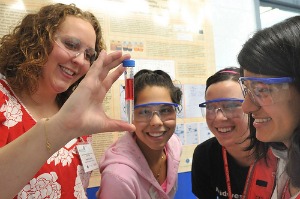Tackling the Shortage of Latinos in Math and Science
 And then there is the other story that needs to be told, and told again.
And then there is the other story that needs to be told, and told again.
Not to undermine a vastly troubling problem in our community, but the drop out rate is not the only headline concerning Latinos and education. There are other issues and within them a widely unseen glimmer of better things.
For instance, a little story in the Press-Enterprise of Riverside California calls attention to the lack of Latinos in college math and science programs. The PE tells the story of Matt Valdez, a neuroscience graduate student who worked his way through college, surmounted great obstacles and has followed a path few Latinos consider. The biggest of those obstacles has been money.
“Latinos are underrepresented throughout higher education, but particularly in STEM majors, according to the National Center for Education Statistics. In 2006, Latinos were 19 percent of the college-aged population but received only 8 percent of STEM bachelor’s degrees and 3.5 percent of master’s degrees.”
It’s not that Latinos aren’t smart enough to be scientists, we all know that’s a crock. The problem is that the production of scientists is expensive. But not impossibly so. Case in point, Valdez got a job as a janitor as soon as he graduated form high school, his prospects for college almost nil. But then he did what many Latinos do, what many if not most of you reading this did.
“Nearly 60 percent of graduating Latino college seniors worked an average of 30 or more hours a week while at university, a grueling schedule that the USC reports say reduces the likelihood of completing a degree.“
The story behind the story destroys a myth. That is, that although drop out rates and lack of resources prevents Latinos from going to college, there’s a stronger force at work that doesn’t go away. 21 year old Christian Contreras was raised by his single, Mexican immigrant mother who worked as many as three jobs and earned a bachelors degree.
“‘My mom always pushed me to do my best,’ Contreras said. ‘She just put that drive in me from a young age. She made sure I was going to college. There was no other option.’
Contreras paid for his first two years at UCR through grants, scholarships, loans and about 25 hours a week working at a movie theater. During the past two academic years, federal and state grants have covered his tuition, allowing him to concentrate on research.”
It paid off. Contreras co-authored an article on fuel cells that was published as the May cover story in the journal Chemsus Chem. Not too shabby, but rare.
These are great stories that need to be told and we can’t wait for someone else to tell them.
[Photo by Argonne National Laboratory]

